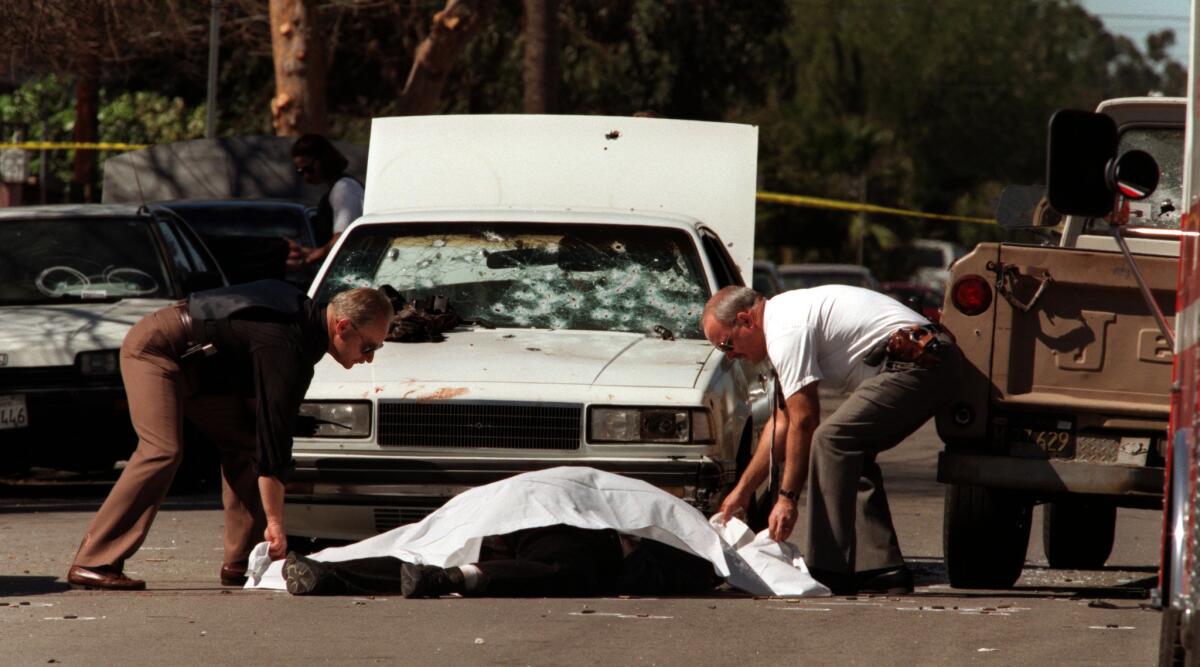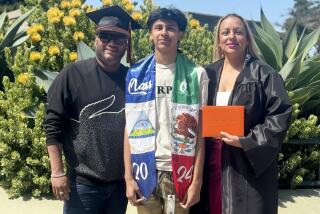20 years ago, a dramatic North Hollywood shootout changed the course of the LAPD and policing at large

- Share via
It began as just another gorgeous L.A. day. Then, shortly after 9 a.m., a spectral scene of combat popped onto TV screens across the city.
Two armor-clad figures standing calmly outside a bank were spewing machine gun fire at a swarm of police officers shooting back with pistols from behind car doors and trees.
Within minutes, the parking lot outside the Bank of America on Laurel Canyon Boulevard in North Hollywood was on television screens across the country, as disbelieving viewers watched the battle unfold on live feeds from network helicopters circling overhead.
For 44 minutes, out-gunned officers engaged the bank robbers, dodging barrages of high-powered bullets, rescuing their wounded and peppering their targets with hundreds of shots that bounced off harmlessly.
Gradually their shots probed openings in their adversaries’ armor as a SWAT team arrived from afar to equalize the firepower. The North Hollywood shootout ended with the two perpetrators — Larry Eugene Phillips Jr., 26, and Emil Dechebal Matasareanu, 30 — dead in the street. Eleven officers were wounded, but none killed.
Twenty years ago today, the bravery and boldness of LAPD officers gave a badly needed shine to the image of a department that had been sullied by the beating of Rodney King, the loss of control in the Los Angeles riots and the investigative missteps that became fodder for O.J. Simpson’s defense.
The assault on police shocked law enforcement across the country, prompting a widespread trend to beef up police armament. It also inspired Los Angeles and other cities to enact their own gun control measures when the state failed to do so.
“There’s so many things that took place that kind of shook the conscience,” said Donald W. De Lucca, the president of the International Assn. of Chiefs of Police and a police chief in Florida. “It created a shift.”
Like the LAPD, agencies began upgrading weapons for their patrol officers, giving them high-powered rifles that are now common in police cars. Street cops were trained to use those weapons so they wouldn’t have to wait for SWAT officers at a quickly unfolding scene. The LAPD also authorized officers to carry high-caliber handguns that exceed the stopping power of the standard-issue sidearms.
Retired LAPD Capt. Greg Meyer, who is considered an expert in police tactics and training, said North Hollywood is still mentioned in police classrooms across the country as a landmark moment for law enforcement. The lesson, Meyer said, is simple: “You never know when something like that is going to happen in your city or your town, and you need to be prepared.”
Los Angeles City Atty. Mike Feuer, who was then a councilman, said the shootout was the catalyst for a raft of local gun control laws he pushed through, including a ban on high-capacity magazines, a limit of one firearm purchase per month and the creation of an ammunition log.
“All these measures flowed from my initial reaction to the North Hollywood shooting,” Feuer said.
The officers’ accounts of the shootout were detailed in what is called a Use of Force report, a review prepared for the Los Angeles Police Commission every time an officer shoots a gun or applies other potentially injurious force.
In the clinical voice of event reconstruction the 25-page document tells a harrowing narrative of the first wave of officers arriving being cut to pieces, then being covered and rescued by a second wave, as dozens of others filled in behind them, keeping up a relentless fire with pistols until still others with rifles arrived.
“Numerous officers engaged the suspects at their own peril to save other officers and citizens,” it concluded. “Although numerous rounds were fired, the officers utilized controlled fire. As a result, the suspects, who were attired in body armor, were distracted and their escape attempt was obstructed.
“It is apparent that the officers’ actions prevented further injury and death to citizens and ultimately stopped the suspects’ deadly threat.”
Seven of the officers who were in the thick of it that day, all but one now retired, wrote retrospectives for the February issue of the Los Angeles Police Protective League’s magazine, The Thin Blue Line.
Some simply recounted what they remembered.
“I saw my rounds hit his black jacket, and as I shot at him, he kept coming,” said retired Det. Thomas Culotta. “Was this a dream? I wasn’t sure, but as this specter made eye contact with me, he pointed his weapon and fired right at me…. I remember asking God, ‘Is this the day?’ Death was coming.”
Others noted the lessons learned from that day.
“The shooting changed history for law enforcement nationwide,” said retired Capt. Nicholas Zingo, then a gang officer who was dispatched to a North Hollywood gun shop to borrow high-powered rifles. “Weaponry was upgraded, tactics and strategies were changed and improved! LAPD was on top—the best.”
Retired Officer John Caprarelli zeroed in on a less obvious reaction — mandatory counseling for those experiencing PTSD: “Others won’t have to helplessly watch as family members or co-workers single-handedly deal with issued they don’t fully understand.”
“I am still surviving this ordeal,” said retired Officer Martin Whitfield, the most seriously injured. “Multiple surgeries and many months of physical and mental therapy immediately followed the shooting.
“Although I remember every minute of Feb. 28, 1997, I cherish every minute after that day and have developed a lifestyle of surviving,” he said.
The shootout also left a mark on legal precedent, by what it didn’t change.
Whitfield, who had four bullet wounds including one that smashed his femur just below the hip, sued several gun makers, advancing the novel product liability theory that they should have known their guns were “ultra-hazardous products.”
The case was stopped on appeal by a finding that “it would be unwise to adopt a broad new theory of recovery, which would ultimately make courts and juries the arbiters of the merit of every consumer product in the market.”
Another lawsuit, filed on behalf of Matasareanu’s children, alleged that officers essentially murdered the suspect by neglect as he bled to death.
(An investigation by The Times had concluded that he would have survived his wounds if treated in time, but that a series of mishaps and mistakes, mainly by paramedics, were responsible for his death.)
A jury deadlocked nine to three in favor of the city and officers. The children dropped the case to avoid being counter-sued for malicious prosecution.
Loyola Law School Associate Dean Laurie Levenson saw a foreshadowing of future turmoil in the dissenting votes against the officers in that case.
In the current climate, she added, “the police are starting at a different point. They used to be saluted. Now they’re being viewed with some skepticism.”
The surreal TV coverage of the shooting did not go unnoticed by those seeking meaning in the shootout.
“What does it mean, that this vicious burst of human frailty could have looked for all the world like entertainment?” Times columnist Shawn Hubler asked the following day. “What does it mean, other than that the dramatized account of Friday’s terrifying events will be coming soon to a theater near you?”
It did, but not soon. “44 Minutes: The North Hollywood Shoot-Out” premiered on TV in 2003.
Twitter: @LATDoug
Twitter: @katemather
ALSO
Three people are killed when small plane crashes into Riverside neighborhood
More to Read
Sign up for Essential California
The most important California stories and recommendations in your inbox every morning.
You may occasionally receive promotional content from the Los Angeles Times.















